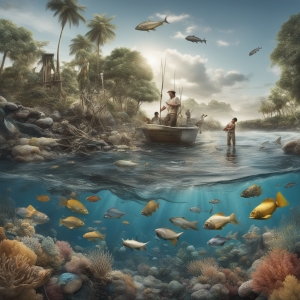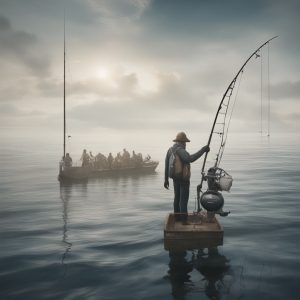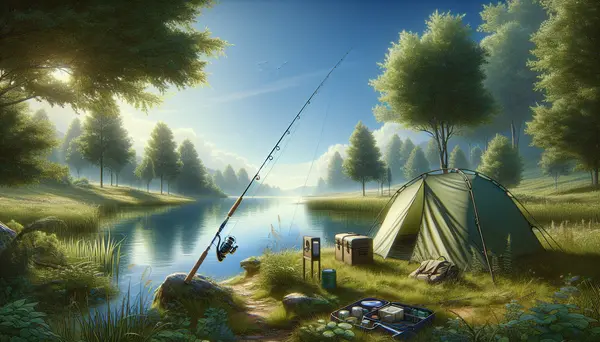Table of Contents:
Our oceans are more than just a body of water. They are a living, breathing entity crucial to our very survival. But years of overfishing have led to the significant decline of fish populations worldwide. Ensuring the future of our oceans requires each one of us to step up and adopt sustainable fishing practices.
Sustainable Fishing: Ensuring Our Ocean's Future
The alarming decline of fish populations can be attributed to unsustainable fishing methods. High-tech equipment and aggressive fishing practices have turned the once abundant oceans into declining fish fields. However, change is not only possible but imperative for the survival of our ecosystems and future generations.
Sustainable fishing is the answer. It is conscientious, mindful, and takes into account the impact on fish species and their habitats. But, what does it really entail and how can we adopt this approach?
In essence, sustainable fishing practices aim to maintain ample fish stocks for future generations. It seeks to minimize damages to the marine environment and prevent overfishing. Sustainable fishing also respects the intricate marine food web, understanding that every species, no matter how small or big, plays a crucial role.
However, adopting sustainable fishing methods is not just the responsibility of professional fishermen and fishing companies. As responsible individuals, we can contribute to the preservation of our oceans. By making informed choices about the seafood we consume and supporting those who employ sustainable fishing practices, we can make a difference.
The Importance of Sustainable Fishing
Our oceans are a vital part of the Earth's biodiversity. The variety of organisms that form a complex, interdependent network makes the marine ecosystem incredibly rich but also sensitive. Sustainable fishing is crucial as it reflects the balance that needs to exist between humans and nature.
Overfishing disrupts this balance and leads to the depletion of fish species, threatening the entire marine ecosystem. The importance of sustainable fishing stems from its nature. It respects the need of fish species to breed and grow to a size that maintains their population, while giving consideration to the ecosystem in which they live.
Employing sustainable methods also reduces bycatch - the accidental capture of non-target species during fishing. This is important because bycatch can include endangered species that might not survive return to their habitat. Therefore, sustainable fishing practices directly contribute to the preservation of species diversity and the health of our oceans.
Beyond environmental considerations, sustainable fishing is also critical for economic reasons. A well-managed, sustainable fishery leads to stable jobs and creates a sustainable source of food for many communities around the world. Hence, the importance of sustainable fishing is multifold, affecting aside from the environment, the economy and food security as well.
Advantages and Disadvantages of Sustainable Fishing Practices
| Pros | Cons |
|---|---|
| Secures the future of marine life | May limit immediate fishing productivity |
| Helps maintain a healthy marine ecosystem | Requires strict regulations and enforcement |
| Potential for long-term economic benefits | Short-term profit loss for the fishing industry |
| Supports the livelihood of coastal communities | Requires retraining and education for fishers |
| Contributes to food security | May require expensive gear upgrade |
Changing Mindsets Towards Fishing

Developing the right mindset about fishing is a critical step towards promoting sustainable fishing practices. This change needs to begin from the individual level and extend to community, policy and global levels. We must view ourselves not as conquerors of the oceans, but as stewards, responsible for their well-being.
While the oceans have been a rich source of food and a means of livelihood for millions over the years, we must understand that they are not inexhaustible. We need to move away from the idea of fishing without limits and shift towards considering the impact on the marine ecosystem. Recreational and local fishers, as well as consumers, can all play a role in this shift.
A key change in mindset involves recognising that each one of us has a role in protecting our oceans. Opting to consume fish and seafood sourced from sustainable fishing practices and questioning where our seafood comes from is one way to contribute. Supporting policies and regulations that encourage sustainable fishing is also vital.
Changing mindsets towards fishing also includes the need to respect all forms of marine life, not just the popular and commonly consumed species. It involves acknowledging that each species has a role in maintaining the balance of the ecosystem.
Ultimately, shifting our perspectives and fostering a deep respect for the marine ecosystem is the first step towards ensuring the continuity of diverse, healthy and vibrant oceans for ourselves and future generations.
Modern Sustainable Fishing Techniques
With the widespread adoption of sustainable fishing as a goal, several modern techniques for achieving this have emerged. It is no longer about just catching the maximum amount of fish, but doing so in a way that respects and conserves the marine ecosystem.
One effective technique is the use of Fish Aggregating Devices (FADs), that are designed to attract fish without causing harm. These FADs can be free-floating or anchored to the ocean floor and are used as an eco-friendly way of gathering fish together, making them easier to catch while also minimizing bycatch.
Another notable sustainable fishing technique is pole-and-line fishing. This traditional method allows for selective fishing, targeting only mature individuals of the desired species. This method minimizes bycatch and does not damage the seafloor or other habitats.
Trap fishing is a technique that makes use of cages or traps to catch fish. These traps are designed in a specific manner to allow only a certain size and type of fish to enter, limiting bycatch and ensuring that juvenile fish can escape.
Another modern fishing technology is the application of Marine Protected Areas (MPAs). These are designated regions of the sea where human activity is restricted to protect the marine biodiversity. By preserving certain areas from fishing, fish populations have the opportunity to recover and breeding can take place successfully.
Overall, the evolution of sustainable fishing techniques is ongoing, as technology and our understanding of marine ecosystems continues to develop. And while they might require a greater initial effort, the long-term benefits offered by these methods are undeniable. Not only for fish stocks and the marine environment, but also for the thousands of people who rely upon fishing as their livelihood.
The Role of Regulations in Sustainable Fishing

Legislation plays a pivotal role in sustainable fishing. As the threats to our oceans increase, stronger policies are needed. They can enforce standards and guidelines to be adhered by both commercial and recreational fishers, worldwide.
Regulations that manage catch quotas restrict the amount and the specific species that a fisherman can catch. They bring scientific data into the process, ensuring that fish populations can replenish before they are further targeted. This allowance of breeding time helps maintain a healthy fish population. Regulations also encourage the use of selective fishing gears that drastically decrease bycatch. This method ensures that non-target, often endangered species, are not accidentally harmed.
Marine protected areas (MPAs) are another direct result of regulations. By creating these areas, habitats essential to the life cycle of marine species are preserved. MPAs thus play an instrumental role in sustaining marine biodiversity.
Furthermore, the establishment of 'no take' zones provides a sanctuary for marine life, allowing ecosystems to function uninterrupted. They can help to restore overfished stocks and protect vulnerable areas from the impacts of human activities.
In addition, regulations push for transparency and traceability in the seafood industry. Knowing where and how our seafood is caught can lead to greater consumer confidence, encouraging support for sustainable fishing.
However, the implementation of these regulations requires commitment both from governments and the fishing industry. By working together, sustainable fishing can become the norm, not the exception, safeguarding our oceans for the generations to come.
Sustainable Fishing Practices Around the Globe
Across the globe, sustainable fishing practices are gaining traction as more stakeholders recognize the need for change. They are key to preserving fish stocks and improving the health of our oceans. So, what do some of these practices look like?
In Norway, for instance, fisheries have implemented quotas and are investing heavily in research to understand fish populations better. This knowledge helps to set more accurate fishing limits to prevent overfishing. They have also adopted the use of selective fishing gear to limit bycatch.
In the Pacific Islands, locals rely on traditional, sustainable fishing methods that have been passed down through generations. These include the use of traps and fences that allow younger fish to escape, ensuring that they can reproduce and maintain the population.
Alaska's approach to sustainable fishing is held as a gold standard around the globe. Strict laws are in place to dictate when and where individuals can fish, and all fisheries must operate under the guidance of the state's constitution, which mandates sustained yield principles.
These methods highlight the importance of sustainable fishing practices and their role in conserving fish species, preserving biodiversity, and maintaining the health of marine ecosystems. The variety in these practices underlines that sustainable fishing is adaptable to different ecosystems and cultures. By sharing and learning from these methods, we can adopt these practices globally and secure our oceans' future.
Conclusion: It's Time to Choose Sustainable Fishing

There is no denying - the future of our oceans hangs in balance, teetering between abundance and depletion. It is our collective responsibility to tip the scales towards abundance by implementing sustainable fishing practices. When we choose to fish sustainably, we aren't just choosing to conserve marine life, we're choosing life itself.
Today, as we understand the devastating effects of overfishing and the importance of sustaining our marine ecosystems, we find ourselves at an important crossroad. The path we choose will shape the future of our planet. We must maintain the delicate balance of our marine ecosystems, not only for the survival of our marine life but also for food security, livelihoods and a thriving planet. It is high time we prioritize sustainable fishing and make a conscious effort to conserve our aquatic organisms and their habitats.
Let our choices be guided by the profound understanding that every creature in our oceans matters, and that our own survival is deeply intertwined with theirs. In making these choices, we are also choosing the kind of world we leave behind for the generations to come.
Sustainable fishing is no longer a choice. It's a necessity. It's the only way to ensure that our oceans continue to be teeming with life, providing us with the resources we need to survive and thrive on this planet. It's time to fish sustainably and proudly carry the mantle of being the guardians of our oceans.
FAQ: Key Practices for Sustainable Fishing
What is Sustainable Fishing?
Sustainable fishing is the practice of catching fish without jeopardizing the ecosystems and species within them. It ensures that people can continue to fish over the long term without harming our oceans' ability to regenerate.
Why is Sustainable Fishing Important?
Sustainable fishing is crucial for maintaining healthy aquatic ecosystems and ensuring economic survival for communities that rely on fishing. It also helps to preserve species from overfishing and extinction.
What are the Key Practices for Sustainable Fishing?
Key practices include respecting habitats, reducing bycatch, fishing responsibly and legally, being aware of the seasons, and supporting local and small-scale fisheries.
How Can Consumers Support Sustainable Fishing?
Consumers can support sustainable fishing by choosing seafood that is responsibly sourced, checking for sustainability certifications, and supporting businesses that prioritize sustainable fishing practices.
What is the Impact of Overfishing?
Overfishing leads to a decrease in the population of fish species, which can disrupt the balance of the entire marine ecosystem. This can lead to the extinction of certain species, negatively affect the livelihood of fishing communities, and diminish the overall health of our oceans.







